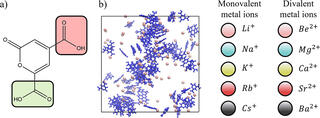Computational modeling provides insight into ion-mediated molecular aggregation

Background/objective
Lignin, one of three main parts of plant cell walls, is a potential source of renewable chemicals such as PDC (2-Pyrone-4,6-dicarboxylic acid), which can be used to make bioplastics. Crystallization is a common method for separating PDC from fermentation broths, but scientists don't fully understand the interplay of interactions that drive this aggregation and structure formation and how they depend on the charge of PDC and ionic species present.
Approach
Scientists used all-atom molecular dynamics simulation and molecular clustering analysis to investigate PDC aggregation in diverse ionic solutions. Researchers systematically modeled PDC molecules with different degrees of acid dissociation and in the presence of various metal ions to investigate the role of pH and determine conditions that lead to aggregates with parallel molecular stacking, which is expected to promote crystallization.
Results
Acid dissociation facilitates PDC aggregation in ionic solutions through ion-mediated interactions, and different ionic solutions influence the likelihood of aggregation and the formation of parallel aggregates. Parallel stacking was primarily found in solutions with monovalent ions, while divalent ions promote larger but less structured aggregates. Results indicate that the choice of ion in solution can impact the interplay of PDC–PDC stacking, PDC–water hydrogen bonding, and electrostatic interactions that influence aggregate structures.
Impact
Results provide molecular-scale insight into the effects of specific ions on aggregation of like-charged PDC molecules to inform understanding of related separation processes, with relevance to industrial applications in pharmaceuticals, solar cells, sensing, detergents, coatings, and food.